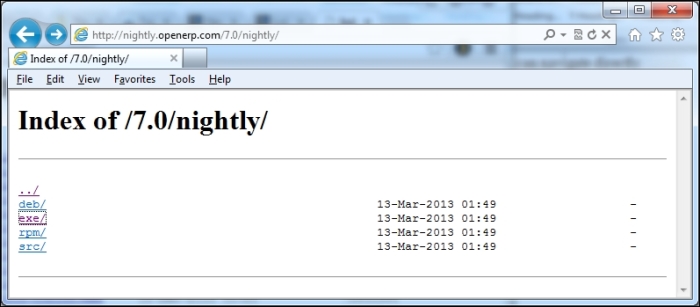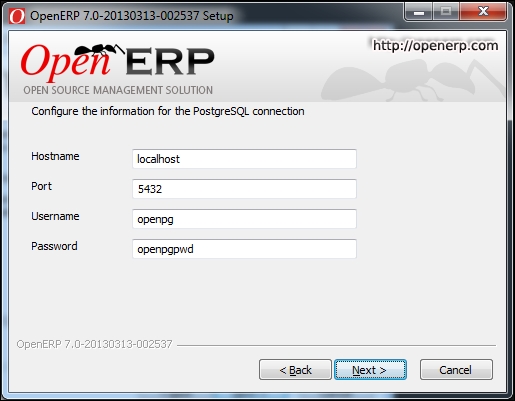We begin our installation by locating the packages that are currently available to install. You can find the current list at:

The preceding screenshot is the OpenERP Nightly builds page, that is, the jumping-off point for downloading the source files for installation.
The examples and case studies in this book use OpenERP 7.0. This means you should select the 7.0 LTS (stable) version of OpenERP to download. You can navigate directly to the 7.0 OpenERP downloads here:
http://nightly.openerp.com/7.0/nightly/
Tip
It is entirely possible that OpenERP will change the URL as new versions are released. To best follow the examples in this book, download a 7.x installation of OpenERP.

Windows installations use the EXE packages. Click on the exe/ directory as shown in the preceding screenshot to get the list of downloads that are available.
Naturally, the specific download packages are going to change on a nightly basis.

The latest version of the stable LTS release will contain the most current OpenERP build with bug fixes included and will appear at the bottom of the list. By the way, the upload dates you'll see are in Coordinated Universal Time (UTC) and therefore may be many hours ahead of your time zone, especially if you live in the Western Hemisphere.
Installing OpenERP using the all-in-one package is very simple. After the package has finished downloading, double-click on the EXE file to begin the installation wizard.
The first screen will prompt you to select the language for your installation.
After you have selected the language and clicked on the OK button, the wizard will continue with the installation.

After clicking on the Next button you will see the license screen followed by a prompt to select the type of install.
Tip
I highly recommend that you select the Custom install so you can select the directory for installation. The default directory name contains the lengthy build number making it rather difficult to work with in the command prompt.

We have changed the type of install to Custom so that we may set the directory name later in the setup wizard.
Next the wizard prompts for the credentials to connect to the PostgreSQL database that will be installed.

It is recommended that you change the username and password for security purposes. The default username and password are shown in the preceding screenshot. These values will be written into the OpenERP configuration file. The username and password provided will be the administration credentials for the PostgreSQL database so be sure to remember them.
After clicking on the Next button you will be prompted for the installation directory.

You will notice that the default installation directory is quite cryptic. While you can use this default directory, it quickly becomes tedious to type when you need to perform operations at the command prompt. Therefore it is recommended that you change the destination folder to something more manageable. For example, why not change the directory name to simply OpenERP?
Once you click on the Install button, the wizard will finish installing OpenERP to your selected directory.

After the wizard is complete, if you leave Start OpenERP checked and then click on the Finish button, OpenERP should open up in your default browser.
If OpenERP fails to launch, you can look at the Troubleshooting OpenERP installations section later in this chapter for solutions to some of the problems commonly encountered during installation.



